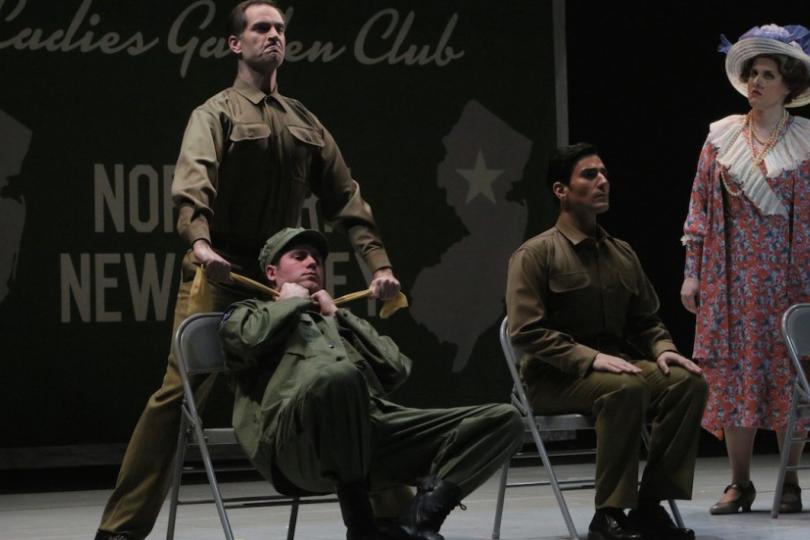This is your candidate

If you don’t tend to keep up with the classical music scene, opera seems like a world apart from theater. It operates in a separate sphere, with none of the actors, directors, or designers that you might recognize if you see yourself as a theater person. So let me get you up to speed: aside from hosting innovative productions of classic works, like last season’s Magic Flute where the actors interacted with projections on a giant screen, the Minnesota Opera also has a program called the New Works Initiative, where they commission and stage a new opera each year. One of these new works, Silent Night, won the 2012 Pulitzer Prize for its incredibly moving portrayal of the Christmas Eve truce of 1914.
Got your attention? Good. Because The Manchurian Candidate was not only created by the same composer-librettist team that wrote Silent Night, but it is innovative in a way that even opera newbies can appreciate. First of all, consider the source material, a 1959 book by Richard Condon that was later turned into two star-studded movie versions with cast members including Angela Lansbury, Frank Sinatra, Meryl Streep, and Denzel Washington. If you turned that into a play, people would worry that you were just trying to re-create the movie. But an opera opens new doors: on the Ordway’s massive stage, with full orchestration, this interpretation digs into some juicy Cold War tensions in a different way that doesn’t feel at all redundant.
Composer Kevin Puts’s music is not jarring or hard to listen to in the way some people expect from contemporary classical music, but it does help to be clued into what you’re hearing. Like the movies the opera is based on, The Manchurian Candidate is about 1 hour and 40 minutes of tension (yes, there is such a thing as an opera that isn’t painfully long), and to sustain that, there are motifs that it’s fun to listen for. First of all, the central source of conflict is that Sergeant Raymond Shaw has been brainwashed – and to express that musically, you’ll hear the vocalists and various instruments suddenly switching gears into a long string of repeated notes (what’s called an ostinato).
Because this also deals with mid-century America, Puts also weaves in a variety of musical genres – snippets from “The Star Spangled Banner”, bits of a John Philip Sousa march, jazz rhythms, or a hint of blues. There are moving scenes that could be straight out of the best musical theater, but Puts also has a brilliant sense of irony: hypocrisies are highlighted by sugary-sweet music, and a spouse’s words of calming reassurance are made to sound awfully similar to earlier “brainwashing” motifs. In other words, it’s a fully contemporary opera that innovates musically in ways that won’t alienate new audiences.
How well does it work theatrically?
Along with its obvious musicality, opera is also theater. And The Manchurian Candidate creates a compelling theatrical experience, starting with Japhy Weideman’s lighting and Robert Brill’s minimalist set. The action all takes place in a sort of prison yard-operating theater, where prisoners of war can be turned into unwitting assassins by shadowy scientists. The spotlights, which seem to follow Shaw everywhere, are shone down from windows in what might be guard towers, and the sense of a Panopticon is heightened even further by three large television screens and an array of lighting instruments hanging from the center of the stage.
The opera’s design makes it unquestionably clear that along with being a fast-paced thriller, this is also a production that wants you to think about what images you are being shown, and how those images influence what you believe. For instance, there are several key moments that are filmed by an on-stage cameraman and broadcast to the audience on the hanging screens. I love this idea for two reasons: on a theoretical level, it makes us think about the mediatization of politics. And on a very practical level, it means that even viewers in the back of the Ordway have a chance to see some of the performers’ faces as they sing.
Speaking of the performers: although I don’t feel qualified to comment on the singers’ vocal abilities, to my untrained ear they sound phenomenal. And I did note that they all had stand-out theatrical moments, particularly in scenes that were less about the suspense and more about humanizing the characters. Brenda Harris played Eleanor Iselin as a marvelous villain with some powerhouse arias, but she also has exchanges with her son that are both tender and deliciously creepy. Although the character of Captain Ben Marco mostly exists to convince Shaw that he’s been brainwashed, Leonardo Capalbo ’s portrayal of Marco’s PTSD is gripping, and he also has a really fun flirtation with Adriana Zabala (playing Rosie Chayney) on a train.
The character of Sergeant Shaw doesn’t really have a chance to develop until after intermission, when he discovers the extent of his brainwashing – but that’s where Matthew Worth really shines. Shaw’s romance with Jocelyn Jordan (Angela Mortellaro) is also a high point of the production, both for its dramatic impact and the way the music shifts to mirror the characters’ blissful states of mind.
Innovations past and to come
The opera shares many of the same pitfalls and challenges as the theater community: for instance, I would love to see the Minnesota Opera commissioning work by female composers and taking steps to cultivate artists and audiences of color. But The Manchurian Candidate is one of many innovative productions in a genre that is stereotyped for its conservatism, and the Minnesota Opera should be recognized for all the work it does – including building a very active social media and YouTube presence – towards breaking down barriers to coming to the opera.
I recently read an article suggesting ways that classical music concerts could move away from the stodgy old conventions that often alienate new audiences. It advocates many things that The Manchurian Candidate already does, such as allowing drinks inside the hall, using screens to broadcast details to audience members in the cheap seats, and incorporating contemporary works and unpredictability into each program. Listen up, theater artists – opera is staging its comeback.




